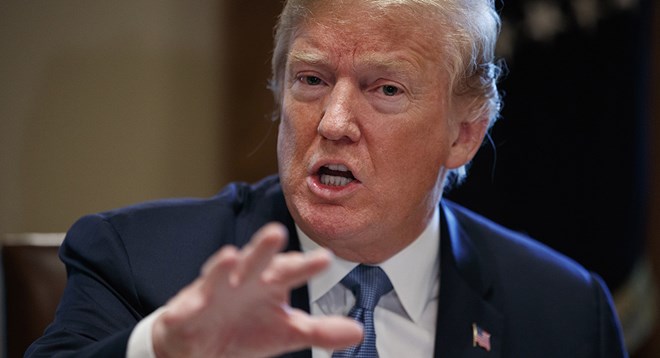
Friday December 21, 2018
By Matt Sedensky And Julie Watson

President Donald Trump had previously argued that efforts at passing an immigration reform bill in the House were futile because any measure would face grim prospects at best in the Senate. | Evan Vucci/AP Photo
NEW YORK — Children torn from parents, refugees turned away and a relentless stream of changes to immigration regulation and enforcement.
advertisements
To those who champion President Donald Trump and believe cracking down on immigration translates to better lives for Americans, 2018’s breathless headlines were a fulfilment of campaign promises. To many others, they harkened back to dark moments in U.S. history.“This is our generation’s sort of existential moment,” said Frank Sharry, head of pro-immigration group America’s Voice. “Are we going to continue to be a nation that practices ‘e pluribus unum’ and welcomes people from around the world to make this country better? Or are we going to shut the door?”
Throughout 2018, the answer has largely been the latter.
Even as those living in the U.S. illegally remain targets, the administration has sought to redefine what legal immigration looks like, too, slowing or halting those seeking to come to the country for a job offer, through their relationship to a citizen, or to find a home as a refugee or asylee.
“There has been this constant chip, chip, chipping away at the legal immigration system using every tool of the executive branch,” said Doug Rand, who worked in the Obama administration before helping found Boundless Immigration, which helps people navigate the immigration system.
Related Stories:
'The toughest year': US immigration changes dominated 2018
US says migrants will wait in Mexico after claiming asylum
Judge blocks restrictions on who can apply for asylum
Trump’s so-called “travel ban,” the first iteration of which was unveiled in the president’s first week in office, was upheld in June by the U.S. Supreme Court, stopping most visas for residents of Libya, Iran, Somalia, Syria, Yemen, North Korea and Venezuela.
It’s had very real consequences for people like Soolmaz Dadgari, an Iranian who came to the U.S. in 2017 so her 4-year-old daughter, Arina, could take part in an experimental study to treat a rare genetic disorder. Dadgari’s husband has been unable to get a visa to join them, and sanctions make it hard for him to send money. She alone cares for a child who can’t walk or talk and requires 24-hour help, as well as another 11-year-old daughter.
“I have no hope,” said Dadgari.
Though global wars, persecution and famine have persisted, the U.S. capped refugee admissions at 45,000 for the fiscal year that ended Sept. 30, the lowest ceiling since the State Department began tracking the figure in 1980. Far fewer were actually admitted in that time frame — about 21,000 refugees — and the number is likely to fall further, with the cap for the current fiscal year set at 30,000.
Meantime, tens of thousands fleeing violence in Central America sought asylum in the U.S. this year. The Trump administration responded by narrowing who is eligible, declaring that neither those escaping gang violence or domestic abuse nor those who cross the border illegally qualify. Both changes have been blocked by federal courts.
“I don’t know what to do,” said Ivis Munoz, a 26-year-old coffee farmer from Altima, Honduras, who joined a caravan heading to the U.S. in October after a gang member shot him and threatened to kill him. He planned to seek asylum but learned along his journey he was unlikely to be accepted. For now, he remains in Mexico. “I want to go to the United States, though I’m scared they’ll send me back. I’m afraid to be in Honduras, but I don’t feel safe here either.”
More than any other shift in policy, the Trump administration’s move to separate apprehended migrant children and parents shook people around the world. Though Trump eventually ended widespread use of the practice, scars remain.
Evelin Roxana Meyer and her family have struggled financially, so her husband set off for the U.S. in hopes of finding work, bringing their son along. They were picked up by Border Patrol agents and separated, with the father deported and the son spending four months in detention. He turned 12 alone at a Texas facility, and the once-affectionate boy returned home angry in September. He rarely goes out, spending most of his time in his room watching TV. He’s refused to go to school and will have to repeat the sixth grade. He talks back to his parents and hits his little sister.
“This was the toughest year of all,” said 38-year-old Meyer.
Many who support Trump, though, see hope in the president’s actions.
Neil Gouveia came to the U.S. from Guyana as a 7-year-old and considered himself a “liberal New Yorker” until 2016, when he was drawn to Trump for what he believed was his strength on national security. He thinks the year’s action on immigration will ultimately lead to greater dialogue and better policies, and he still believes America stands as a beacon for much of the world.
“People will say what they want to say about America, but there’s hardly anyone who still wouldn’t want to come here,” said Gouveia, 39, a collegiate fundraiser. “They still know it’s like winning the lottery.”
Daniel Stein, who heads the Federation for American Immigration Reform, which supports restrictive immigration measures, believes the year’s imagery has moved more people to his side of the debate. To those who see an extended assault on a cornerstone American value, he’s unmoved.
“They have a vivid imagination,” Stein said. “We have one of the world’s most generous immigration programs.”
——
Watson reported from San Diego. Associated Press writer Gisela Salomon contributed reporting from Miami.